
Tornadoes
When I first started looking for data on tornadoes, sometime in the early 2000s, it was mostly static data, news articles and so on. Open media such as TornadoVideos.Net didn't exist and the Fujita scale was known as, well, the "Fujita" scale! That's all changed.
So much has been achieved, since I first started taking an interest in tornadoes and so much new data acquired that the Fujita–Pearson scale, the "absolute" reference as far as tornadoes went got "Extended" as new frontiers were explored, at no small cost but much great fun professionals such as Reed Timmer and the late Tim Samaras invented new ways of retrieving more efficient data in the hope of making the world, their world, a lot safer for mankind.

Living in a region where the climate is generally temperate with no really serious meteorological phenomena to speak of, other than floods, the remains of hurricane storms that bring a month's worth of rain in a day and the no more so rare "Storms of the Century" Tornadoes are things that happen elsewhere. Yes, Europe regularly experiences tornadoes but most barely attaining level 1 on the Extended Fujita scale, invariably go unnoticed and while it is true that tornadoes can happen anywhere from Argentina to Zimbabwe* nowhere do they happen with such regularity and intensity as in the USA.
What is a Tornado?
A Tornado is a violent, rotating column of air that descends with a familiar funnel (or tube) shape from a cumulonimbus cloud. If the cloud does not reach the surface, it is called a funnel cloud; if it touches ground it's called a Tornado, if it touches water, it is called "Waterspout ".
Within the tornado's funnel-shaped cloud, winds can attain speeds up to 300 miles per hour, while the forward speed of the tornado averages only 40 knots.
Tornadoes occur with isolated thunderstorms at times, but much more frequently they form with thunderstorms associated with fast-moving cold fronts supercells
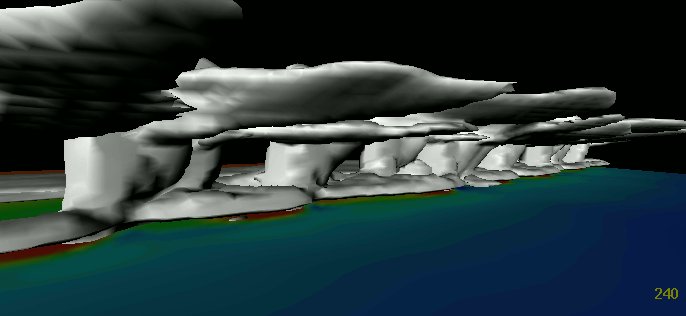 Squall line computer simulation |
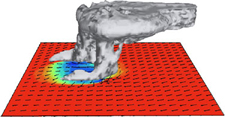 Supercell |
 Supercell graphic |
Click on images to enlarge
Tornadoes - What are they?
- A tornado is a violently rotating column of air extending between, and in contact with, a cloud and the surface of the earth. Tornadoes are also called "Twisters" because of the way they move in fast spinning motions across the ground. They rise and fall during their journey but it's when they touch ground that they
Tornadoes are invariably generated by thunderstorms, though they have been known to occur without the presence of lightning. The stronger tornadoes attain an awe-inspiring intensity, with wind speeds that exceed 200 mph and in extreme cases may approach 300 mph(Fig1).- Before thunderstorms develop, a change in wind direction and an increase in wind speed with increasing height creates an invisible, horizontal spinning effect in the lower atmosphere. Rising air within the thunderstorm updraft tilts the rotating air from horizontal to vertical.
NB. If you are inside a building stay inside with doors and windows shut. Stay away from the windows and exterior walls. Go to small interior room or stairwell on lowest floor of building (bathrooms are often best). If possible, crouch under large/heavy furniture. Protect your head with cushions or mattresses. If you are outside seek immediately shelter in a building, not a vehicle. If none are available, lie flat in low dry spot (e.g.: a ditch) or under low bridge,.Beware of flooding! As a last resort hang on tightly to the base of a shrub or small tree. If you are in a vehicle get out, leave it. Do not try to outrun it (most people actually drive into the path of a tornado). If possible run to nearby solid building (see above).
- Tornadoes form suddenly and are often preceded by warm humid weather and always produced by thunderstorms, though not every thunderstorm produces a tornado. Warning signs include:
- · Severe thunderstorms with frequent thunder and lightning
· An extremely dark sky sometimes highlighted by green or yellow clouds
· A rumbling sound, such as a freight train might make or a whistling sound such as a jet aircraft might make
· A funnel cloud at the rear base of a thundercloud often behind a curtain of heavy rain or hail.- Tornadoes are violent windstorms characterized by a twisting funnel-shaped cloud, which forms at the base of cloud banks and points towards the ground. Tornadoes usually move over the ground at anywhere from 20 to 90 km/h and often travel from the southwest to the northeast. They are erratic and can change course suddenly, so you need either to be crazy or well informed or well equipped or all that at the same time if you want to go and chase tornadoes.
Generally speaking, May to September is tornado season, although tornadoes are regularly recorded in April. Tornadoes also generally hit in the afternoon and early evening but they have been known to strike at night as well.
- Tornadoes are formed when there is thermal instability. This occurs when cool dry air from Canada meets moist warm air from the Gulf of Mexico. The warm air rises and the cool air falls causing a vortex. The vortex sucks everything near it into its centre as it takes its funnel-like shape. Sometimes there is more than one funnel formed at a time.
The diameter of a tornado can be anything from a few feet wide to a mile wide. Tornados are really fast too; they can spin at about 200-300 miles per hour. All the debris that the tornado picks up as it moves across the ground is sucked up inside the funnel and is spat out of the top.
- Tornadoes can be small, slow and do very little damage but others can be very large and destructive. They normally bring with them, thunderstorms and heavy rain and are very noisy! The Fujita scale (Fig1) is used to measure how bad the tornado is and classes them as weak, strong or violent.
- Weak tornadoes are the most frequent; they are thin and tall like a rope hanging from the sky. Strong tornadoes have a wider funnel and account for about three out of ten tornadoes.
- Only violent tornadoes are capable of flattening houses, even then, they are only likely to flatten poorly constructed buildings so you are usually quite safe. Violent tornadoes travel at about 200 miles per hour.
- Tornadoes get their colour from the debris and dirt they have picked up, the darker the funnel the more dirt.
Fujita - Pearson Scale for Tornado Damage, as of February 2007(Fig1)
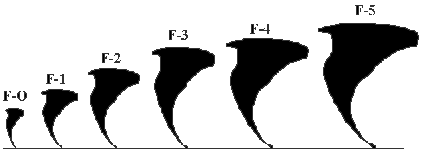

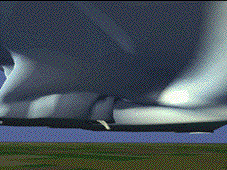
Tornado Animation
What causes tornadoes?
Thunderstorms develop in warm, moist air in advance of eastward-moving cold fronts. These thunderstorms often produce large hail, strong winds, and tornadoes. Tornadoes in the winter and early spring are often associated with strong, frontal systems that form in the Central States and move east. Occasionally, large outbreaks of tornadoes occur with this type of weather pattern.
During the spring in the Central Plains, thunderstorms frequently develop along a "Dryline," which separates very warm, moist air to the east from hot, dry air to the west. Tornado-producing thunderstorms may form as the dryline moves east during the afternoon hours.
Along the front range of the Rocky Mountains, in the Texas panhandle, and in the southern High Plains, thunderstorms frequently form as air near the ground flows "upslope" toward higher terrain. If other favorable conditions exist, these thunderstorms can produce tornadoes.
Tornadoes occasionally accompany tropical storms and hurricanes that move over land. Tornadoes are most common to the right and ahead of the path ofFamilies of tornadoes or tornado vortices have been observed as appendages of the main cloud, extending 20 miles outward from the area of lightning and precipitation. They may last from a few minutes up to 6 hours. These vortices usually occur on the southern or southwestern flank of the storm.
Tornado vortices can be masked by innocent-looking cumulus clouds trailing the thunderstorm and may or may not be visible to alert the unwary crew member. The invisible vortices may only be evidenced by swirls in the cloud-base or by dust-whirls boiling along the ground but may be strong enough to cause severe structural damage to the aircraft. Phenomena frequently encountered by naval personnel at sea are known as waterspouts.
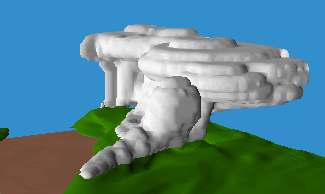
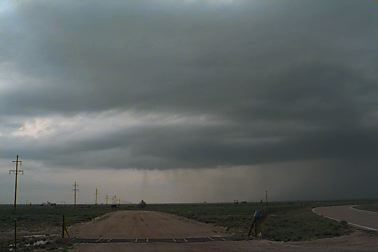
NB. This picture is of an Upslope flow in eastern New Mexico underneath yet another disturbance exiting the southwestern U.S. created a pattern marginally favorable for supercells. One did develop northeast of Roswell, New Mexico and drifted northeastward towards Hobbs and Tatum. The storm became super-cellular rapidly and went through several stages quickly.
This view towards the due north shows the original, occluded mesocyclone in the far background, with a rain curtain wrapping around its north and west side. A new rain free base was developing directly overhead. This storm eventually linked up with other storms in the area to form a raging squall line which slammed the Lubbock, Texas area around midnight. A tornado
Where do tornadoes strike?
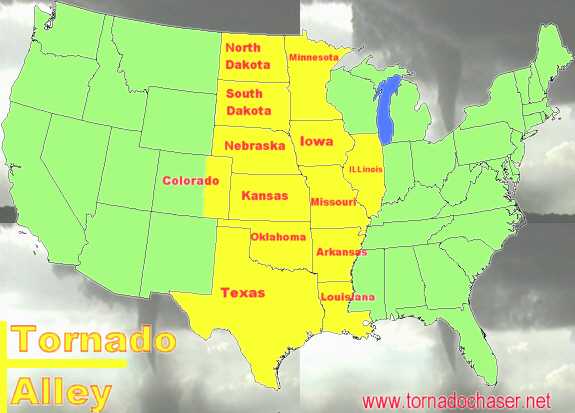
In the USA
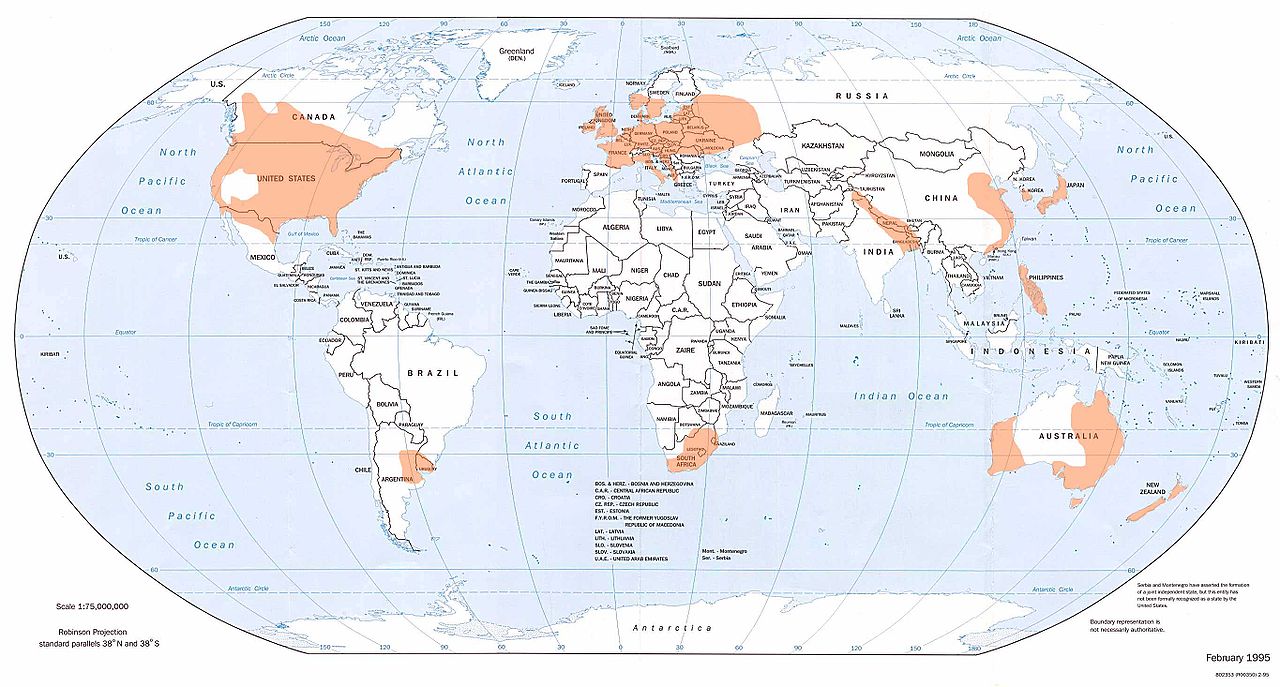
...and elsewhere
Tornado facts
With winds of up to 200 MPH(Fig2), the tornado is one of the most savage storms on earth. It is a narrow, violently rotating column of air extending from the base of a thunderstorm and touching the ground. All thunderstorms are capable of producing tornadoes but not systemically with lightning. The funnel clouds are most likely to appear when the following conditions are present:
- unseasonably warm and humid air near the ground, cold air above it and strong winds above the cold layer. The warm air ascends, mixing with the cold, and a spinning action results.
How strong are tornadoes?
While most tornadoes (69%) have winds of less than 100 miles an hour, they
can be much much stronger.
· Violent tornadoes (winds greater than 205 miles an hour) account
for only 2% of all tornadoes, they cause 70% of all tornado deaths
· In 1931, a tornado in Minnesota lifted an 83-ton railroad train with
117 passengers and carried it more than 80 feet!
· Once a tornado in Oklahoma carried a motel sign 30 miles and dropped
it in Arkansas!
· In 1975, a Mississippi tornado carried a home freezer more than one
Scale |
Winds |
Damage |
Frequency |
|
EF0 |
40 to 72 MPH |
Some damage to chimneys, TV antennas, roof shingles, trees, and windows. |
29% |
|
EF1 |
73 to 112 MPH |
Automobiles overturned, carports destroyed, trees uprooted |
40% |
|
EF2 |
113 to 157 MPH |
Roofs blown off homes, sheds and outbuildings demolished, mobile homes overturned. |
24% |
|
EF3 |
158 to 206 MPH |
Exterior walls and roofs blown off homes. Metal buildings collapsed or are severely damaged. Forests and farmland flattened. |
6% |
|
EF4 |
207 to 260 MPH |
Few walls, if any, standing in well-built homes. Large steel and concrete missiles thrown far distances. |
2% |
|
EF5 |
261 to 318 MPH |
Homes leveled with all debris removed. Schools, motels, and other larger structures have considerable damage with exterior walls and roofs gone. Top stories demolished. |
Less than 1% |
|
EF6 |
319 to 379 MPH |
Although suspected to exist it is difficult to distinguish between F5 and F6 tornados and measure the damage differential. |
Less than ?% |
Tornado statistics
Tornado variations
Frequency of Tornadoes (When)
Tornado myths
MYTH: Areas near rivers, lakes, and mountains are safe from tornadoes.
FACT: No place is safe from tornadoes. In the late 1980's, a tornado swept through Yellowstone National Park leaving a path of destruction up and down a 10,000 ft. mountain.MYTH: The low pressure with a tornado causes buildings to "explode" as the tornado passes overhead.
FACT: Violent winds and debris slamming into buildings cause most structural damageMYTH: Windows should be opened before a tornado approaches to equalize pressure and minimize damage.
FACT: Opening windows allows damaging winds to enter the structure. Leave the windows alone; instead, immediately go to a safe place.
How tornadoes form?
- Before thunderstorms develop, a change in wind direction and an increase
.
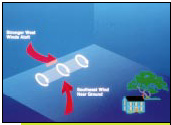
- Rising air within the thunderstorm updraft tilts the rotating air from horizontal to vertical.
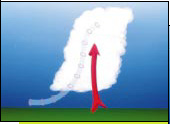
- An area of rotation, 2-6 miles wide, now extends through much of the storm. Most strong and violent tornadoes form within this area of strong rotation.
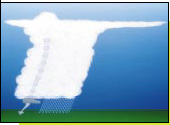
Tornadoes. What environmental clues to look for
Caution:
Tornadoes take many Shapes and Sizes
Weak Tornadoes:
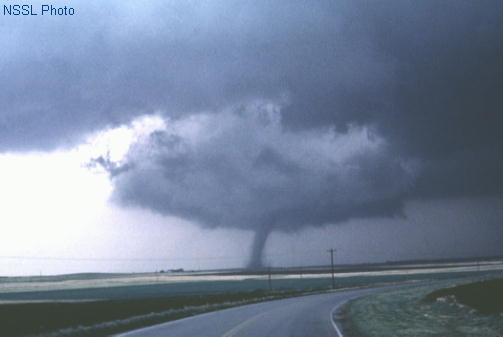
Strong Tornadoes:

Violent Tornadoes:
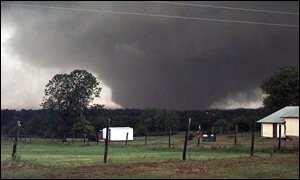
Acknowledgments:
Links:
www.nssl.noaa.gov/
www.chaseday.com/links-1.htm
www.tornadochaser.net
Disclaimer. The text and images on this page have been taken from educational, public and non commercial sites and as such this material is for a strictly personal and non-commercial use. It is free for use and may be copied but no responsibility will be taken and no liability accepted for its future use once leveraged.
©N.Richards-2008, updated 11/2014